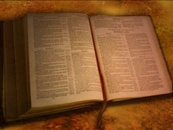 In yesterday’s article, I presented a view of the inspiration of Scripture which I think is more consistent with the actual contents of Scripture than any other view. In considering that view, we looked at several statements that both Peter and Paul made about their writings. Today, I’d like to look at a few pieces of circumstantial evidence which support that view. Those who regularly spend time reading the Bible will be very familiar with the fact that it often contains information which could not have been known by the human writer without direct revelation from God. Most of the instances of this occur in the passages in which the human writer is recording audible communication which he received from the Lord. For example, the prophecies of Daniel were obtained when he was in direct communication with God, and there are many views of inspiration which are compatible with the human writer recording this kind of knowledge. There are other times, however, when the writers of Scripture recorded events of which they had no knowledge, but they did so in the same manner in which they recorded events of which they were eyewitnesses. The view of inspiration which we considered yesterday is the only such view which can account for these portions of Scripture without resorting to wild speculation.
Let’s consider a few examples. Toward the end of the Gospel of Matthew, is found the following depiction of Christ’s prayer in the Garden of Gethsemane: Then cometh Jesus with them unto a place called Gethsemane, and saith unto the disciples, Sit ye here, while I go and pray yonder. And he took with him Peter and the two sons of Zebedee, and began to be sorrowful and very heavy. Then saith he unto them, My soul is exceeding sorrowful, even unto death: tarry ye here, and watch with me. And he went a little further, and fell on his face, and prayed, saying, O my Father, if it be possible, let this cup pass from me: nevertheless not as I will, but as thou wilt. And he cometh unto the disciples, and findeth them asleep, and saith unto Peter, What, could ye not watch with me one hour? Watch and pray, that ye enter not into temptation: the spirit indeed is willing, but the flesh is weak. He went away again the second time, and prayed, saying, O my Father, if this cup may not pass away from me, except I drink it, thy will be done. And he came and found them asleep again: for their eyes were heavy. And he left them, and went away again, and prayed the third time, saying the same words. Then cometh he to his disciples, and saith unto them, Sleep on now, and take your rest: behold, the hour is at hand, and the Son of man is betrayed into the hands of sinners. (Matthew 26:36-45) This passage is recorded by Matthew in the same style as the rest of the book. There is no indication that Matthew received a special vision from the Lord in which he was shown this event, nor is there any record of him being told of it by an angel. Matthew records the prayer of Christ in the same narrative style as the rest of the book, and yet, the text informs us there was not a single human witness to this prayer. The only reasonable explanation for this is that Matthew’s Gospel was actually authored by the One who was present to witness this event which was God. Thus, the view that every word of Scripture was directly authored by God Himself is supported by this passage in Matthew. Another example of this can be found in the fourth chapter of Luke’s Gospel which records the temptation of Christ by Satan. Luke records for us that this temptation took place at a time when our Lord was “led by the Spirit into the wilderness.” There were no witnesses around to view this interaction between Christ and Satan, and yet, Luke records these events as if he had received the account from an eyewitness. In fact, he specifically claims that his record is from eyewitnesses in the introduction to his Gospel when he says that “they delivered them unto us, which from the beginning were eyewitnesses.” (Luke 1:2) Now, Matthew also includes an account of the temptation of Christ, so it would be possible for Luke to have received an eyewitness report from him except for the fact that there were no human witnesses around to have given the account to Matthew. The only witnesses to Christ’s temptation were God and Satan. Thus, Matthew and Luke’s accounts of this temptation are only possible if at least one of their accounts is the product of God’s direct authorship. We could mention several additional examples such as, for instance, the burial of Moses, but this will suffice to demonstrate the point. The content of the Scriptures is such that there are numerous instances for which the direct authorship of God is the only adequate explanation.
0 Comments
Your comment will be posted after it is approved.
Leave a Reply. |
Bill Fortenberry is a Christian philosopher and historian in Birmingham, AL. Bill's work has been cited in several legal journals, and he has appeared as a guest on shows including The Dr. Gina Show, The Michael Hart Show, and Real Science Radio.
Contact Us if you would like to schedule Bill to speak to your church, group, or club. "Give instruction to a wise man, and he will be yet wiser: teach a just man, and he will increase in learning." (Proverbs 9:9)
Search
Topics
All
Archives
June 2024
|


 RSS Feed
RSS Feed